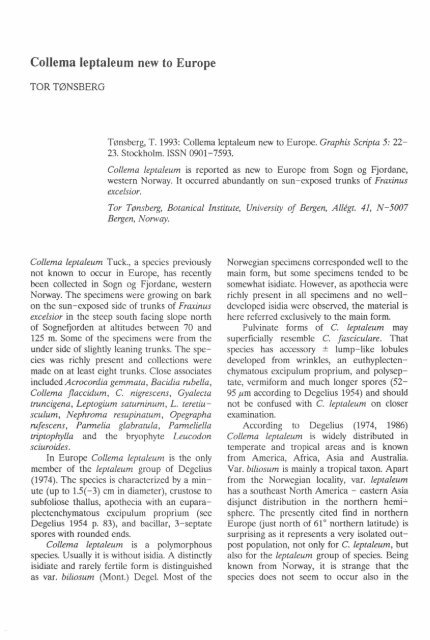CRAPHIS ScnIPTA - Universitetet i Oslo
CRAPHIS ScnIPTA - Universitetet i Oslo
CRAPHIS ScnIPTA - Universitetet i Oslo
You also want an ePaper? Increase the reach of your titles
YUMPU automatically turns print PDFs into web optimized ePapers that Google loves.
Collema leptaleum new to Europe<br />
TOR T@NSBERG<br />
TOnsberg, T. 1993: Collema leptaleum new to Europe. Graphis Scripta 5: 22-<br />
23. Stockholm. ISSN 0901-7593.<br />
Collema leptaleum is reported as new to Europe from Sogn og Fjordane,<br />
western Norway. It occurred abundantly on sun-exposed trunks of Fraxinus<br />
excelsior.<br />
Tor Tensberg, Botanical Institute, Universiry of Beryen, All€gt. 41, N-5007<br />
Bergen, Norway.<br />
Collema leptaleurn Tuck., a species previously<br />
not known to occur in Europe, has recently<br />
been collected in Sogn og Fjordane, western<br />
Nonvay. The specimens were growing on bark<br />
on the sun-exposed side of trunks of Fracinus<br />
excelsior in the steep south facing slope north<br />
of Sogne{orden at altitudes between 70 and<br />
L25 m. Some of the specimens were from the<br />
under side of slightly leaning trunks. The species<br />
was richly present and collections were<br />
made on at least eight trunks. Close associates<br />
included Acrocordia gemmata, Bacidia rubella,<br />
Collema flaccidum, C. nigrescens, Gyalecta<br />
truncigena, Leptogium saturninum, L. teretiusculum,<br />
Nephroma resupinatum, Opegrapha<br />
rufescens, Parmelia glabratula, Parmeliella<br />
triptophylla and the bryophyte Leucodon<br />
sciuroides.<br />
In Europe Collema leptaleum is the only<br />
member of the leptaleum group of Degelius<br />
(L974). The species is characterized by a minute<br />
(up to 1.5(-3) cm in diameter), crustose to<br />
subfoliose thallus, apothecia with an euparaplectenchymatous<br />
excipulum proprium (see<br />
Degelius 1954 p. 83), and bacillar, 3-septate<br />
spores with rounded ends.<br />
Collema leptaleum is a polymorphous<br />
species. Usually it is without isidia. A distinctly<br />
isidiate and rarely fertile form is distinguished<br />
as var. biliosum (Mont.) Degel. Most of the<br />
Nonvegian specimens corresponded well to the<br />
main form, but some specimens tended to be<br />
somewhat isidiate. However, as apothecia were<br />
richly present in all specimens and no welldeveloped<br />
isidia were observed, the material is<br />
here referred exclusively to the main form.<br />
Pulvinate forms of C. leptaleum may<br />
superficially resemble C. fasciculare. That<br />
species has accessory -{- lump-like lobules<br />
developed from wrinkles, an euthyplectenchymatous<br />
excipulum proprium, and polyseptate,<br />
vermiform and much longer spores (52-<br />
95 pm according to Degelius 1954) and should<br />
not be confused with C. leptaleum on closer<br />
examination.<br />
According to Degelius (L974, 1986)<br />
Collema leptaleum is widely distributed in<br />
temperate and tropical areas and is known<br />
from America, Africa, Asia and Australia.<br />
Var. biliosum is mainly a tropical tn(on. Apart<br />
from the Nonuegian locality, var. leptaleum<br />
has a southeast North America - eastern Asia<br />
disjunct distribution in the northern hemisphere.<br />
The presently cited find in northern<br />
Europe (iust north of 61" northern latitude) is<br />
surprising as it represents a very isolated outpost<br />
population, not only for C. leptaleum, bvt<br />
also for the leptaleum grovp of species. Being<br />
known from Nonvay, it is strange that the<br />
species does not seem to occur also in the

















